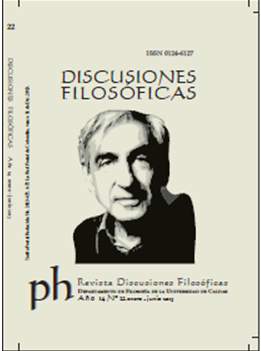Autores/as
Resumen
En la mecánica cuántica, el estado físico de un electrón es descrito por una función de onda. Según la interpretación de probabilidad estándar, la función de onda de un electrón es amplitud de probabilidad, y su modulo cuadrado da la densidad de probabilidad de encontrar el electrón en una cierta posición en el espacio. En este artículo, se muestra que esta suposición central de la mecánica cuántica puede tener una extensión ontológica. Se argumenta que las partículas microscópicas como los electrones son realmente partículas, pero su movimiento no es continuo, sino discontinuo y aleatorio. Desde esta perspectiva, el modulo cuadrado de la función de onda no sólo da la densidad de probabilidad de que las partículas se encuentren en ciertos lugares, sino que también da la densidad de probabilidad de que las partículas estén allí. En otras palabras, la función de onda en la mecánica cuántica se puede considerar como una representación del estado de movimiento discontinuo aleatorio de las partículas, y en un nivel más profundo, puede representar la propiedad disposicional de las partículas que determina su movimiento discontinuo aleatorio.
Citas
---. “The meaning of protective measurements" Found. Phys. 1996: 117. Print.
Aharonov, Y. and L. Vaidman. “Measurement of the Schrödinger wave of a single particle”. Phys. Lett. 1993: 178-238. Print.
Bell, J. S. “Against ‘measurement’”. Miller, A. I. (ed.). Sixty-Two years of uncertainty: Historical philosophical and physics enquiries into the foundations of quantum mechanics. Berlin: Springer, 1990. Print.
Bohm, D. “A suggested interpretation of quantum theory in terms of “hidden” variables, I and II”. Phys. Rev. Jan. 1952: 166-193. Print.
Born, M. “Quantenmechanik der Stovorgänge”. Z. Phys. 1926: 803-827. Print.
Dass, N. D. H. and T. Qureshi. “Critique of protective measurements”. Phys. Rev. 1999: 2590. Print.
DeWitt, B. S. and N. Graham (eds.). The many-worlds interpretation of quantum mechanics. Princeton: Princeton University Press, 1973. Print.
Everett, H. “‘Relative state’ formulation of quantum mechanics”. Rev. Mod. Phys. Jun. 1957: 454-462. Print.
Gao, S. “Comment on “How to protect the interpretation of the wave function against protective measurements” by Jos Uffink”. Phil. Sci. Dec. 2011. Online.
---. “The wave function and quantum reality”. Khrennikov, A., Jaeger, G., Schlosshauer, M. and G. Weihs (eds.). Proceedings of the International Conference on Advances in Quantum Theory. Boston: American Institute of Physics, 2011. Print.
---. “Meaning of the wave function”. International Journal of Quantum Chemistry. Dec. 2011: 4124-4138. Print.
---. “Interpreting quantum mechanics in terms of random discontinuous motion of particles”. Phil. Sci. Feb. 2013. Online.
Lundeen, J. S. et al. “Direct measurement of the quantum wave function”. Physical Review Letters. Feb. 2012: 188-191. Print.
Pusey, M., Barrett, J. and T. Rudolph. “On the reality of the quantum state”. Nature Phys. 2012: 475-478. Online.
Schrödinger, E. “Quantizierung als Eigenwertproblem (Vierte Mitteilung)”. Ann. d. Phys. 1926: 109-139. Online.
Suarez, M. “Quantum propensities”. Studies in the History and Philosophy of Modern Physics. Jun. 2007: 418-438. Online.
Vaidman, L. “Protective measurements”. Greenberger, D., Hentschel, K. and F. Weinert (eds.). Compendium of Quantum Physics: Concepts, Experiments, History and Philosophy. Berlin: Springer-Verlag, 2009. Print.

 PDF
PDF
 FLIP
FLIP





















